m (factories) |
m (engine) |
||
| Line 379: | Line 379: | ||
{{Tractor manufacturers}} |
{{Tractor manufacturers}} |
||
{{Truck manufacturers}} |
{{Truck manufacturers}} |
||
| + | {{Engine manufactures}} |
||
| − | |||
{{Wikipedia}} |
{{Wikipedia}} |
||
| Line 396: | Line 396: | ||
[[Category:Agricultural machinery manufacturers]] |
[[Category:Agricultural machinery manufacturers]] |
||
[[Category:Case IH]] |
[[Category:Case IH]] |
||
| + | [[Category:Engine manufactures]] |
||
Revision as of 15:30, 19 April 2012
 | |
| Successor |
Navistar International Corporation Case IH |
|---|---|
| Founded | Canton, Illinois, USA (1902) |
| Headquarters | Warrenville, Illinois (Present Location) |
| Industry | Agricultural, Automotive |
| Products | Farm Machinery |
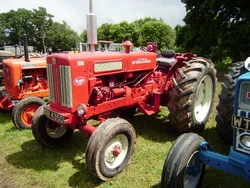
International B614 at Bromyard show 2008
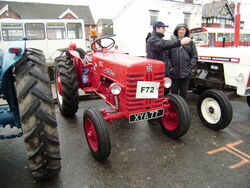
An International B250 at Sandbach Festival of Transport 2008
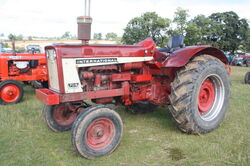
An International 706 at Holcot Steam Rally 2008
International Harvester Company (IHC or IH; now Navistar International Corporation was an agricultural machinery, construction equipment, vehicle, commercial truck, and household and commercial products manufacturer. It was the result of a 1902 merger between the McCormick Harvesting Machine Company and Deering Harvester Company, along with three smaller agricultural equipment firms: Milwaukee; Plano; and Warder, Bushnell, and Glessner (manufacturers of Champion brand). The "International Harvester" Company sold off the Agricultural division in 1985 to Case and later renamed the rest of the company to become the "Navistar International Corporation".
History
Foundation
The roots of International Harvester can be traced back to the 1830s, when Cyrus Hall McCormick, an inventor from Virginia, finalized his version of a horse-drawn reaper. The reaper was demonstrated in tests in 1831 and was patented by Cyrus in 1834. Together with his brother, McCormick moved to Chicago in 1847 and started the McCormick Harvesting Machine Company. The McCormick reaper sold well, partially as a result of their savvy and innovative business practices. Their products came onto the market just as the development of railroads offered wide distribution to distant market areas. He developed marketing and sales techniques, developing a vast network of trained salesmen able to demonstrate operation of the machines in the field.
McCormick died in Chicago, with his company passing on to his son, Cyrus McCormick, Jr. In 1902, the McCormick Harvesting Machine Company and Deering Harvester Company, along with three smaller agricultural equipment firms (Milwaukee; Plano; and Warder, Bushnell, and Glessner (manufacturers of Champion brand)) merged together to create the International Harvester Company.
Steady Growth
UK Production
Downfall and ending
By the end of 1979, IH profits were at their highest in 10 years. Yet, the company was still strapped for cash. Soon after, the economy turned unfavourably against IH, and they became entangled in a financial crisis. A strike lasted approximately six months. When it ended, IH had lost almost $600 million (in 1979 value; over $2 billion today).
By 1981, the company was in trouble. The strike, accompanied by the economy and several internal corporate problems, had placed IH in a hole that had only a slim way out. Things only got worse until 1984, when the bitter end came.
International Harvester, following many hours of negotiations, agreed to sell the Ag division to Tenneco, Inc. on November 26, 1984. Tenneco already had the subsidiary company, J.I. Case, that manufactured tractors, but lacked the full line of farm implements that IH produced (combines, cotton pickers, tillage equipment, etc.)
Following the merger, production of tractors at Harvester's Rock Island, Illinois Farmall Works was ceased in May 1985 when the last IH tractor came off of the assembly line. Production of all of the new Case IH tractors was moved to the J.I. Case Tractor Works in Racine, Wisconsin. Production of IH Axial-Flow combines continued at the East Moline, Illinois combine factory. Harvester's Memphis Works in Memphis, Tennessee was closed and cotton picker production was moved.
The truck and engine divisions remained and in 1986 Harvester changed their corporate name to Navistar International Corporation (Harvester had sold the International Harvester name and the IH symbol to Tenneco Inc. as part of the sale of its Ag division). Navistar International Corporation continues to manufacture medium- and heavy-duty trucks, school buses, and engines under the International brand name.
Factories
Agricultural Equipment Group
- North American Operations
- Other Operations
- Geelong, Australia
- Bradford, England
- Doncaster, Carr Hill, England
- Doncaster, Wheatley Hall, England
- Croix, France
- St. Dizier, France
- Neuss, Germany
- Christchurch, New Zealand
- Pasig, Phillippines
- Pan African Industries, South Africa
- Pietermaritzburg, South Africa
- Joint Ventures
- Industria de Maquinas Agricolas Ideal, S.A., Brazil
- Komatsu Intl. Mfg. Co, Ltd. (KIMCO), Japan
- Mahindra & Mahindra, Ltd., India
- Steiger Tractor, Inc., Fargo, North Dakota, USA
- Turk Otomotiv Endustrilen A.S. (TOE), Turkey
Payline Group
- North American Operations
- Crandiac, Canada
- Gulfport, Mississippi
- Libertyville, Illinois
- Melrose Park, Illinois
- Other Operations
- Doncaster, Wheatley Hall, England
- Yumbo Chauffailles, France
- Yumbo Genas, France
- Heidelberg, Germany
- Christchurch, New Zealand
- Joint Ventures
- Komatsu Intl. Mfg. Co, Ltd. (Kimco), Japan
- MAQUINARIA Hidraulica Mexicana, S.A., Mexico
Solar Turbines
- 4 Plants in San Diego, California
- Superior Gear, Gardena, California
Truck Group
- North American Operations
- Chatham, Ontario, Canada
- Columbus, Ohio
- Emeryville, California
- Fort Wayne, Indiana
- Pacific Truck & Trailer, N Vancouver, British Columbia, Canada
- San Leandro, California
- Springfield, Ohio Body Plant
- Springfield, Ohio Assembly Plant
- Springfield, Ohio Stamping Plant
- Shadyside, Ohio Stamping Plant
- Urbana, Ohio Wiring Plant
- Wagoner, Oklahoma
- Other Operations
- Dandenong, Australia
- Seddon Olkham, England
- Seddon Preston, England
- Chirstchurch, New Zealand
- Pasig, Phillippines
- Pietermaritzburg, South Africa
- Joint Ventures
- Fabricas Autotransporte Mexicana, S.A. (FAMSA), Mexico
- Industria Venezolana de Maquinarias, C.A. (INDEMACA), Venezuela
- Turk Otomotiv Endustrilen A.S. (TOE), Turkey
- Van Doorfne’s Bedrijfswagenfabriek DAF B.V., Netherlands
- Components Group
- Engine Division
- Indianpolis, Indiana
- Melrose Park, Illinois
- Neuss, Germany
- Foundry Division
- Indianapolis, Indiana
- Louisville, Kentucky
- Memphis, Tennessee
- Waukesha, Wisconsin
- Precisions Products Division
- West Pullman, Illinois
- Engine Division
In addition, there were several ReNewing Centers and Parts Distribution Centers
Divisions and products
Agriculture

A restored example of a IH muck spreader at Somerset Tractor Show 2009
The International Harvester Agricultural Division was by far the biggest and best known IH subsidiary. When IH sold their ag division to Tenneco in 1985, the International Harvester name and "IH" logo, went with it.
One of the first early products (besides the harvesting equipment that McCormick and Deering had been making prior to the merger) from the newly created International Harvester Company was the Traction Truck: a truck frame manufactured by Morton Traction Truck Company (later bought IHC) with an IHC engine mounted on it.
From 1902 when IH was formed to the early 1920s, the McCormick and Deering dealerships kept their original brands unique, with Mogul tractors sold at McCormick dealers, and Titan tractors at Deering dealerships, due to the still present competitiveness of the former rivals.
IH produced a range of massive gas-powered farm tractors under both the Mogul and Titan brands. These tractors had varied success but the trend going into the mid-teens of the 1900s was "small" and "cheap".
The first important tractors from IH were the model 10-20 and 15-30. Introduced in 1915, the tractors (which were comparatively smaller than their predecessors) were primarily used as traction engines to pull ploughs and for belt work on threshing machines. The 10-20 and 15-30 both had separate, but similar, Mogul and Titan versions.
IHC did like many companies do to this day, and that was to purchase a number of smaller companies to incorporate their products into the IH dealer range. P&O Plowing and Chattanooga Plow (US spelling) were purchased in 1919. Other brand names they incorporated were Keystone, D.M. Osborne, Kemp, Meadows, Sterling, Weber, Plano, Champion, and the list goes on and on.
In 1924, IH introduced the Farmall tractor, a smaller general-purpose tractor, to fend off competition from the Ford Motor Company's Fordson tractors. The Farmall was the first tractor in the United States to incorporate a tricycle-like design (or row-crop front axle), which could be used on tall crops such as cotton and maize. Following the introduction of the Farmall, IH introduced several similar looking "F Series" models that offered improvements over the original design (the original model became known as the "Regular").
In 1932 IH produced their first diesel engine, introduced in the McCormick-Deering TD-40 crawler. This engine started on gasoline, then switched over to diesel fuel. Diesel engines of this era were difficult to start in cold weather, and the gasoline allowed the engine to start easily and thoroughly warm up before making the switch to diesel in all weather conditions. In 1935 this engine was put in the WD-40, becoming the world's first diesel tractor on wheels.
For model year 1939, industrial designer Raymond Loewy was hired to design a new line of tractors. The sleek look, combined with other new features, created what is known as the Farmall "letter series" (A, B, BN, C, H and M) and the McCormick-Deering "standard series" (W-4, W-6 and W-9). The tractors were updated to the "super" series in the early fifties (with the exception of the A, which became a "super" in 1947, and the B and BN, which were discontinued in 1948) and received several improvements. Many of these tractors (especially the largest: the H, M and W models) are still in operation on farms today. Especially desirable are the diesel-powered MD, WD-6 and WD-9. These tractors carried forward the unique gasoline start diesel concept of the WD-40.
- Main article: Farmall for model details.
The letter and standard series of tractors was produced until 1954, and was a defining product in IH history.
For 1955 in IH tractors, the numbered "hundred-series" was offered. Although given slightly different looks and few new features, they were still updates to the models introduced in 1939. The only new tractor in the 1955 lineup is the 300 Utility. In 1957 IH gave the tractor lineup another update by increasing power in some models, adding a new 230 Utility model, and adding new white paint to the grill and sides and new number designations were given. This improved sales at the time, but IH's inability to change and update was already showing.[2]
In July 1958, IH started a major campaign to introduce a new line of tractors that many dealers hoped would turn around slumping sales. At the Hinsdale, Illinois Testing Farm, IH entertained over 12,000 dealers from over 25 countries. IH showed off their new "60" series of tractors: including the big, first of their kind, six-cylinder 460 and 560 tractors. But the joy of the new line of tractors was short lived. One of the first events that would eventually lead to the downfall of IH presented itself in 1959. In June of that year, IH recalled the 460, 560, and 660 tractors: final drive components had failed. IH, who wanted to be the first big-power manufacturer, had failed to drastically update the final drives on the new six-cylinder tractors. These final drives were essentially unchanged from 1939 and would fail rapidly under the stress of the more powerful 60-series engines. IH's competitors took advantage of the recall, and IH would lose customers in the ensuing months, with many customers moving to John Deere's New Generation of Power tractors introduced in 1960.
Throughout the 1960s IH would introduce new tractors and new methods of selling them. But farming was about to change, and IH, along with their competitors, were in for a bumpy ride.
1973 would see some important milestones for IH. On February 1, 1974 at 9A.M., the 5 millionth tractor came off the assembly line at the Farmall Plant in Illinois. IH was the first tractor manufacturer to accomplish this. Also in 1973, IH officially dropped the "Farmall" name from its tractor. This ended an era that began with the first Farmall "Regular" back in 1924.
In 1977, IH introduced the first Axial-Flow rotary combine. This machine, produced at East Moline, IL, was the first generation of over 30 years of Axial-Flow combines.
As the 1980s began, IH was ready to climb from its own depression and become a leader once more. IH would face a stable economy, yet it would face an unknown fate. In September 1981, IH announced at a dealership meeting the new "50 Series" of tractors. These new tractors would prove once again that IH had the innovation to come out on top. Penned by industrial designer Gregg Montgomery, whose firm later designed the Case IH Magnum series tractors, the new stylish design of the "50 Series" would change the look of tractors forever. IH spent over $29 million to develop this new series, and the result was the latest great lineup of tractors from IH.
There were many technology-related innovations put into the new series. A computer monitoring system called a Sentry was developed, and IH became the first manufacturer to add a computer to a farm tractor. Other new innovations included a "z" shift pattern, an 18 speed synchronized transmission, a forward air flow cooling system, "Power Priority" 3-pump hydraulic system, colon-coded hydraulic lines and controls, and a new rear-hitch system. The 50 Series had an unprecedented three-year or 2,500-hour engine and drive-train warranty, which would later become an industry standard. Although no new sales records were set, IH sold a respectable amount of these tractors during its short production time.
IH was well into the development of a new line of tractors that would revolutionize the ways of farming when the sale of the Ag division was announced. Many of these new features would find their way into the new series of MAGNUM tractors introduced by Case IH in 1987.
Brand names of the Ag division
IH over the years used a number of brand names to market their tractor and harvesting products:
- Titan (1910–1924)
- Mogul (1911–1924)
- McCormick-Deering (1923–1947)
- McCormick (1947–1958)
- Farmall (1924–1973)
- Fairway (1924–1938)
- Electrall (1954–1956)
- International (1902–1985)
Other agricultural products
Along with the prominent tractor division, IH also sold several different types of farm related equipment. These included: balers, cultivators, combine harvesters (self-propelled and pull behind), combine heads, corn shellers, cotton pickers, manure spreaders, hay rakes, crop dusters, disk harrows, elevators, feed grinders, hammer mills, hay conditioners, milking machines, planters, mills, discs, ploughs and various miscellaneous equipment.
Also produced were twine, stationary engines, loaders, and wagons.
In 1954, the Electrall system was introduced. It was a short-lived attempt to market electrically-operated farm equipment and accessories. The system, co-developed with General Electric, consisted of a 208V three phase alternating current generator that is connected with electric cables to the device to be powered. The generator could even power a household. A 10 KW Electrall generator was an option on the Farmall 400 tractor. The mid-mount Electrall unit installs on the Super M-TA, Super W-6TA, 400, 450 and 560 tractors equipped with the I-PTO option, and there also was a 12.5KW PTO-driven version. The possible applications of Electrall power were many, but few made it to market. The marketing materials showed a haybaler being Electrall powered. One of the more novel applications of the Electrall was a device to electrocute insects in the field at night (basically like a modern-day bug zapper, but on a larger scale).
Model Ranges
- Main article: List of International Harvester vehicles
Tractors
A few of the notable models;
- IH Mogul
- IH Titan
- IH Farmall
- IH B52
- IH B250
- IH B275
- IH B414
- IH B450
- IH B614
- International BTD-6 - Crawler tractor
- International TD-18 - Crawler tractor
Machinery

International 3434B tractor loader in as found condition (working)- Compressor unit from rear, exhibited at the Newark VTH show 2008
- IH TD-8CA - 76 hp - crawler with Agri spec 3-point linkage + weights
Construction
- Main article: Payline
International also built construction machinery. Early excavators were Yumbo machines. The main construction equipment division post war expanded and was renamed the Payline division of International Harvester, incorporating the Hough company of wheeled loaders & the Drott tracked shovels. Some products were more linked with the Agriculture division such as industrial tractors and Loaders.
- Models
- IH BTD-6 with Drott loader (std or 4in1 bucket)
- IH TD-6B - Dozer
- IH TD-8 - Dozer
- IH TD-8 (82 series) - refuse option
- IH TD-8B - Dozer
- IH TD-8BSII - Bulgrader
- IH TD-15C - Dozer
- IH 100A - Loader
- IH 100B - Tracked shovel
- IH 100BSII - Tracked shovel
- IH 125B - Tracked shovel
- IH 125BSII - Tracked shovel
- IH 165 - Tracked shovel
- IH 175B - Loader
- IH 175C - Tracked shovel
- IH 620
- IH 630
- IH 630W - Wheeled Excavator
- IH 640
- IH 650
- IH 3644
- IH 3944 B
- IH 3945
- IH 3945 B - Wheeled Excavator
- IH 3964 - Excavator (Yumbo)
- IH 3964 B
- IH 3965 - Excavator
- IH 3965 B - Wheeled Excavator
- IH 3980
- IH 3980 B
- IH 3980L
- IH 3984 B
- IH JCB Backhoe attachment fits the Crawlers
Lawn and garden
- Main article: Cub Cadet
IH branched out into the home lawn and garden business in the 1960s with its line of Cub Cadet equipment, which included riding and walk-behind lawn mowers and snow blowers. Also produced were compost shredders, rotary tillers, Cadet garden tractors, and power washers.
The IH Cub Cadet line was sold to MTD Products in 1981
Vehicles
- Main article: List of International Harvester vehicles
Light duty
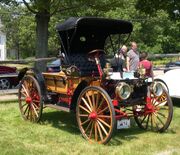
1911 International Harvester wagon

1927 International one-ton stakebed
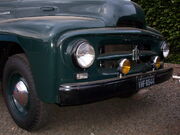
1954 R-110 series pickup
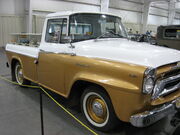
1957 A-series pickup
IH is often remembered as a maker of relatively successful and innovative “light” lines of vehicles, competing directly against the Big 3. The most common were pickup trucks. IH made light trucks from 1907 to 1975. The final light line truck was made on May 5, 1975.
IH had early success with the "Auto Buggy", which started production in February 1907. IHC later introduced the Auto Wagon, which would be renamed the Motor Truck, forerunner to the successful pickup truck. In the mid-1940s, International released their K and KB series trucks, which were more simplistic than other trucks released in that era.
One of the company's light-duty vehicles was the Travelall, which was similar in concept to the Chevrolet Suburban. The Travelette was a crew cab, available in 2 or 4 wheel drive. It was available starting in 1957, and was the first 6-passenger, 4-door truck of its time. The Scout was a small, 2-door SUV, similar to a Jeep. In 1972 the Scout became the Scout II, and in 1974 Dana 44 axles, power steering and power disk brakes became standard. After the pickups and Travelall were discontinued in 1975, the Scout Traveler and Terra became available, both with a longer wheelbase than a standard Scout II.
IH would abandon sales of passenger vehicles in 1980 to concentrate on commercial trucks and school buses. Today the pickups, Travelalls, and Scouts are minor cult orphaned vehicles. All were available as rugged four-wheel drive off-road vehicles.
The Scout & Light Truck Parts Business was sold to Scout/Light Line Distributors, Inc. in 1991.
Medium/Heavy duty
IH was an early manufacturer of medium/heavy duty trucks. Although based upon truck chassis, IH also became the leading manufacturer of the chassis portion of body-on-chassis conventional (type C) school buses. In 1962 IH offered the International Harvester Loadstar which became the premier medium-duty truck. In 1978 IH offered the International Harvester S-Series, which replaced the Loadstar in 1979.
With the truck and engine divisions remaining following the 1985 sale of the agricultural division, International Harvester Company changed their corporate name to Navistar International in 1986. Today Navistar International's subsidiary, International Truck and Engine Corporation, manufactures and markets trucks and engines under the International brand name.
The Power Stroke diesel engine, which is a trade name of Ford Motor Company, is manufactured by International Truck and Engine Corporation, for use in Ford heavy-duty trucks, vans and SUVs.
Military
In early 1951 the United States Army through the Springfield Armoury contracted International Harvester to produce US Calibre .30 M-1 Garand rifles, and between 1953 and 1956 produced 337,623 rifles in total, according to the Army Ordinance Department.
Heavy vehicles manufactured by International Harvester for military use include the 1942 M5 Tractor.
Commercial Vehicles
International D-50 1940
The first commercial vehicles built by International Harvester were highwheeler types, the Auto Buggy and Auto Wagon, that had for a nameplate the company initials of IHC. After 1913 all trucks used the International brand name.
- For a detailed list of American-built models and series see: International Trucks
Some of the notable International truck models and series;
- International 4000 series
- International 5000 series
- International 8000 series
- International 9300 series
- International 9600-9700-9800 series COE
- International A series 1930-35
- International A series 1957-58
- International ACO Sightliner series
- International Auto Wagon
- International B series 1931-35
- International B series 1959-62
- International C series 1934-37
- International C series 1961-62
- International Cargostar series
- International CO/VCO/DCO series tilt-cab
- International CO-4000 series
- International CO-Loadstar series
- International CONCO series
- International CO-Transtar series
- International D series 1937-40
- International Fleetstar series
- International K series
- International KB series
- International L series
- International L/LD 300-400 series
- International Loadstar series
- International Metro series
- International Payhauler series
- International Paystar 5000 series
- International R series
- International R/RD 300-400 series
- International RC/RDC 400 series COE
- International S series 1921-30
- International S series 1956-57
- International S1600-S2100 series
- International S2200-S2300-S2500-S2600 series
- International Scout
- International Transtar 400 series
- International Transtar II series
- International Travelall
- International V series
- International W series "Westcoaster" 1946-49
The Power Stroke diesel engine, which is a trade name of Ford Motors, is manufactured by International Truck and Engine Corporation, for use in Ford heavy-duty trucks, vans and SUVs.
Successor company
- Main article: Navistar International
With the truck and engine divisions remaining following the 1985 sale of the agricultural division, International Harvester Company changed their corporate name to Navistar International in 1986. Today Navistar International's subsidiary, International Truck and Engine Corporation, manufactures and markets trucks and engines under the International brand name.
Other products
For details of other International products, such as refrigerators see: original IH article
See also
- List of Tractor Manufacturers
- List of Engine Manufacturers
- Case IH
- Ford
- John Deere
- Massey-Ferguson
- Construction Plant Manufactures
References
- ↑ http://www.redpowermagazine.com/forums/index.php?showtopic=66972&st=10
- ↑ Updike, Kenneth (2000). International Harvester Tractors 1955-1985. Osceola, WI: MBI Publishing. ISBN 0-7603-0682-6.
External links
- International Harvester History
- International Harvester Digest
- McCormick - International Harvester Collection
- International Harvester information
| ||||||||||||||||||||||||||||||||||||||||||||
| ||||||||||||||||||||||||||||||||||||||||||||
| ||||||||||||||||||||||||||||||||||||||||||||
| This page uses some content from Wikipedia. The original article was at International Harvester. The list of authors can be seen in the page history. As with Tractor & Construction Plant Wiki, the text of Wikipedia is available under the Creative Commons by Attribution License and/or GNU Free Documentation License. Please check page history for when the original article was copied to Wikia |